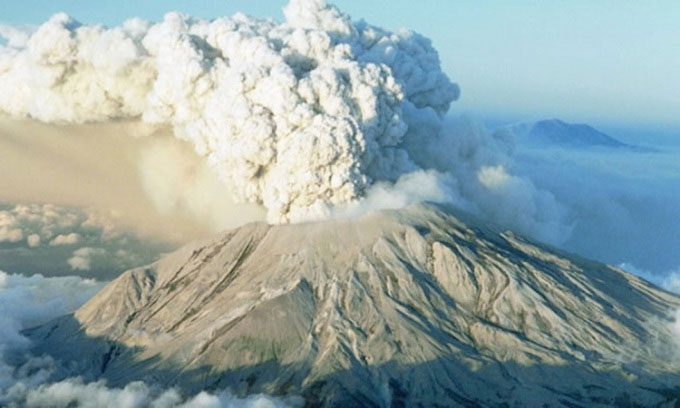On May 18, 1980, Mount St. Helens in Washington State, USA, erupted violently, causing a major earthquake. The eruption resulted in the collapse of the volcano’s summit and triggered a massive landslide. Notably, this landslide is regarded as the fastest in history, reaching speeds of up to 402.3 km/h.
The landslide, traveling at one-third the speed of sound (1,234 km/h), was just a small part of the disaster stemming from the eruption of Mount St. Helens in the spring of 1980. To this day, it remains the deadliest and most destructive volcanic event in U.S. history, according to IFL Science.

Ash plume rising from the summit of Mount St. Helens in 1980. (Photo: History).
According to the United States Geological Survey (USGS), signs of activity at Mount St. Helens began with a series of small earthquakes on March 16, 1980, leading to the volcano’s first eruption in over 100 years on March 27 of that year. Steam and ash broke through the ice cap at the summit, forming a crater 75 meters wide, but the eruption was relatively mild compared to what was to come. Smaller eruptions occurred over the following weeks until April 22, when the first phase of activity ended.
By May 1980, signs of a bulge developing on the north flank of the mountain became increasingly evident. This bulge was the result of magma rising beneath the surface, accumulating pressure similar to a balloon inflating. The worst disaster struck on the morning of May 18, 1980, when Mount St. Helens was jolted by a 5.1 magnitude earthquake. As the tremors occurred, the summit and bulge of the mountain slid away, creating the largest landslide ever recorded.
While the landslide took place on the north flank of St. Helens, a high-pressure magma chamber erupted like the cork from a champagne bottle, causing an explosive eruption that sent volcanic ash flying across an area of 600 km2. The eruption completely devastated the region in just 5 to 9 minutes, killing all living organisms within that range, according to researcher Dan Miller at the USGS.
Experts estimate that the eruption released 100 million trillion joules of energy, with a Volcanic Explosivity Index of 5, the highest level on land in the U.S. However, by the evening of May 18, 1980, the eruption began to slow and ceased entirely the following day.
A total of 57 people lost their lives in the disaster, not to mention the thousands of animals living in the surrounding area. Property damage exceeded $1 billion. Volcanic ash deposits were recorded in at least 11 states across the U.S. and 5 provinces in Canada. Scientists indicate that Mount St. Helens is likely to erupt again, as eruptions here typically occur every 100 to 300 years.


















































